Abstract
The binding of lysophospholipids to rat liver fatty acid-binding protein (FABP) and to BSA and human serum albumin was investigated by using competitive displacement fluorescence assays by monitoring the displacement of the fluorescent fatty acid probe 11-(dansylamino)undecanoic acid (DAUDA). In addition, direct binding assays using changes in tryptophan fluorescence were possible with albumin. Liver FABP was able to bind a range of lysophospholipids, oleoyl-lysophosphatidic acid (lysoPA), oleoyl-lysophosphatidylcholine (lysoPC), oleoyl-lysophosphatidylethanolamine (lysoPE) and oleoyl-lysophosphatidylglycerol, with similar affinity and a Kd of about 1 microM. Liver FABP was also able to bind lysophospholipids generated by the action of phospholipase A2 or phospholipase A1 (triacylglycerol lipase) on phospholipid vesicles. A possible physiological role for liver FABP in lysophospholipid metabolism within the cell is discussed. Albumin was shown to bind lysoPA with higher affinity than either lysoPC or lysoPE, and the initial minimal DAUDA displacement by lysoPA indicated that lysoPA was binding to the primary high-affinity fatty acid-binding sites on albumin and that, like oleic acid, about 3 mol of ligand/mol was bound to these sites. Kd values in the microM range were indicated for lysoPC and lysoPE, whereas, by comparison with oleic acid, the Kd for lysoPA was significantly lower and high-affinity binding in the nM range was indicated. Overall, the data suggest that, because of structural similarity, lysoPA binds to albumin in a similar manner to long-chain fatty acids.
Full text
PDF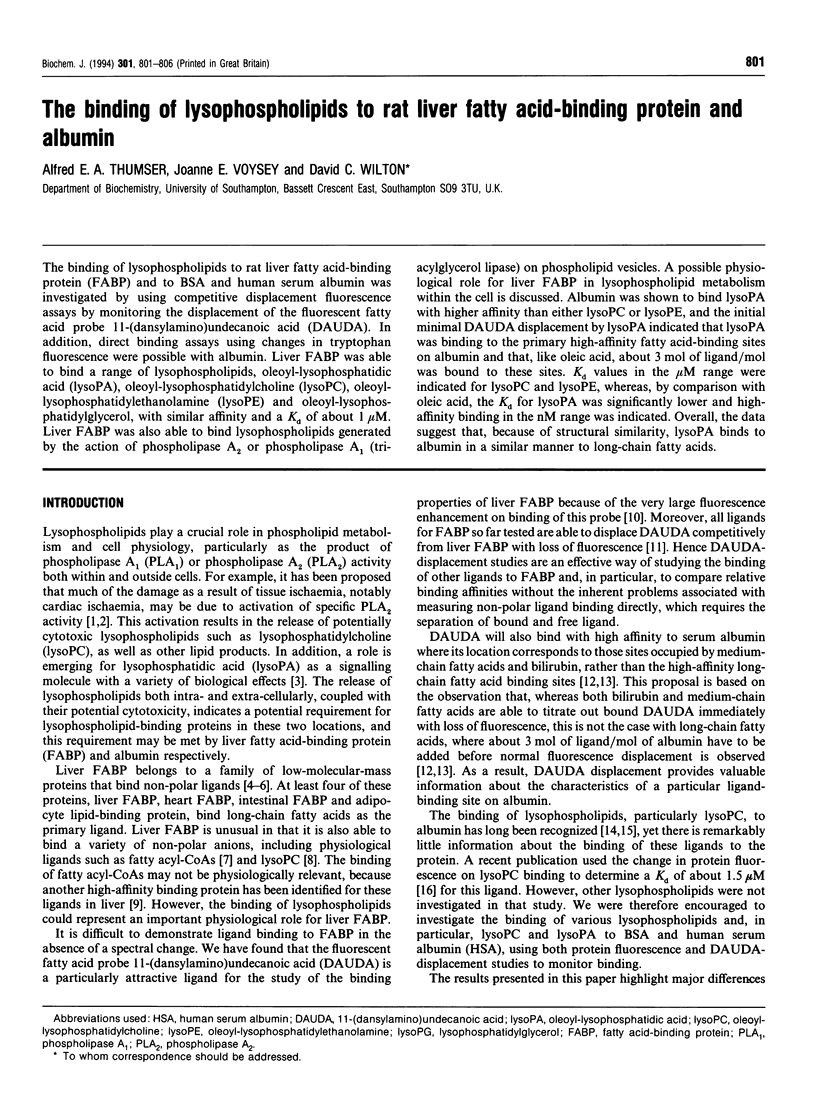
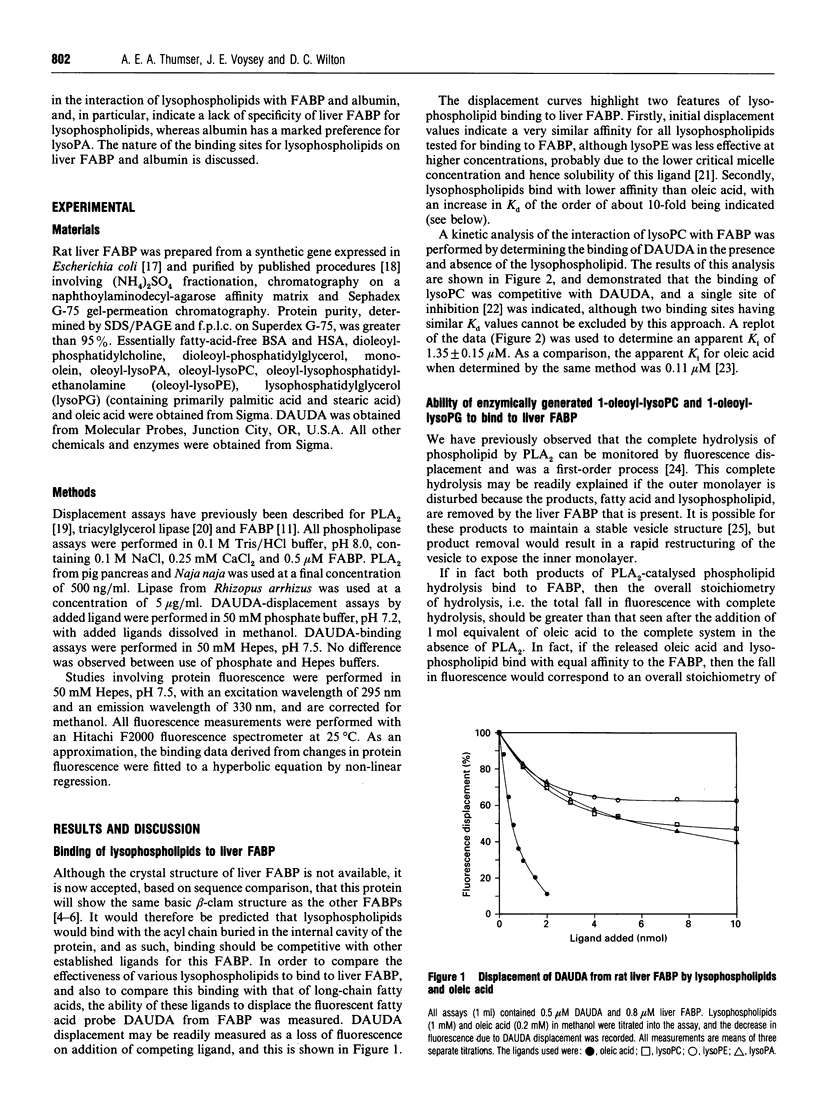
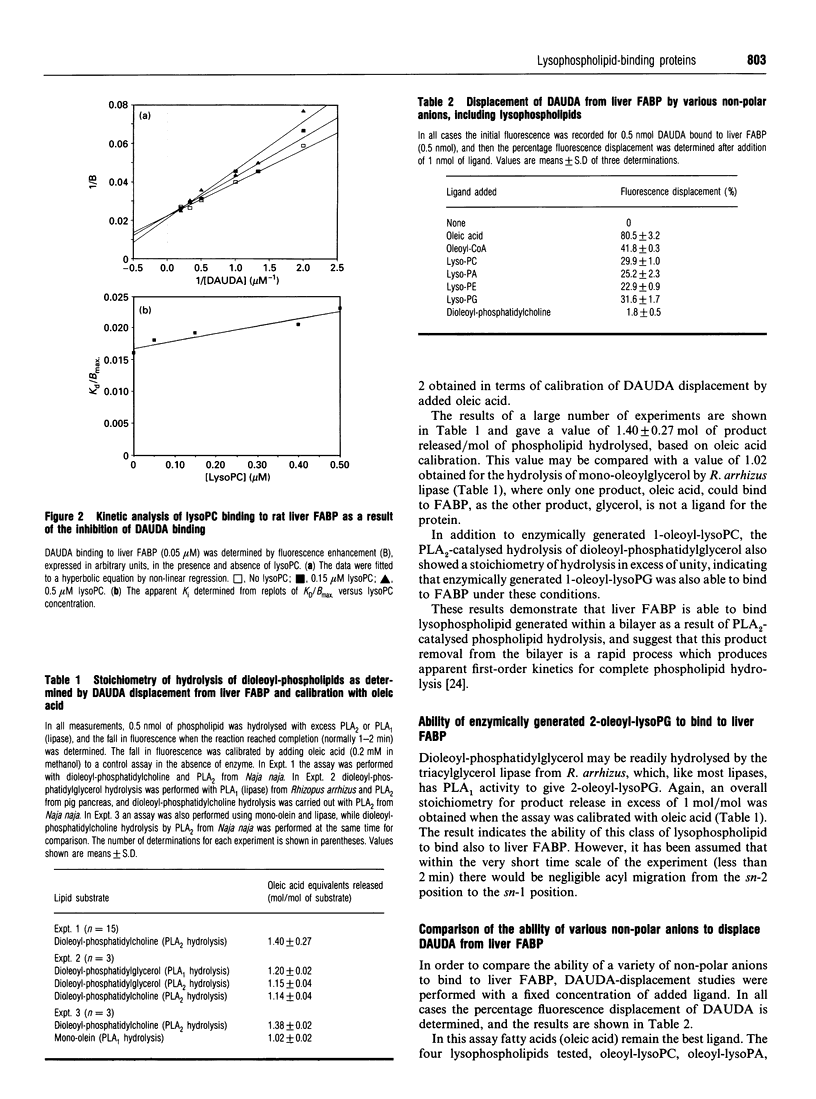
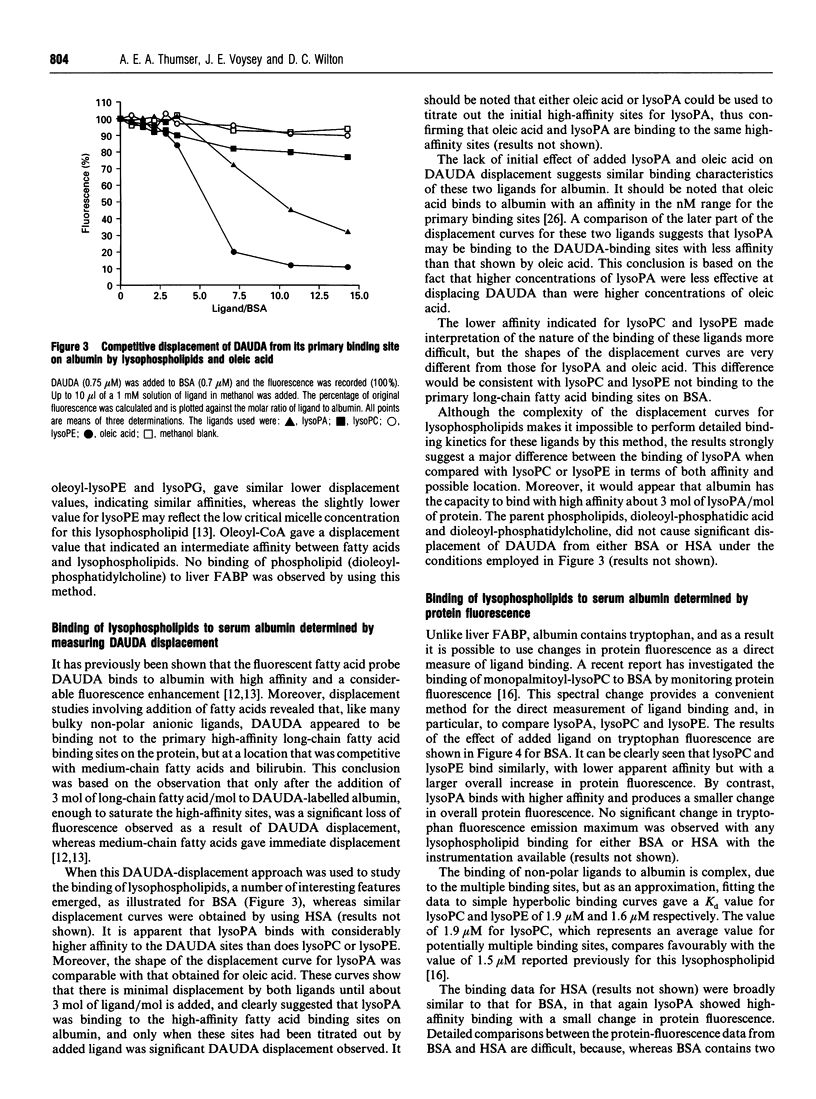
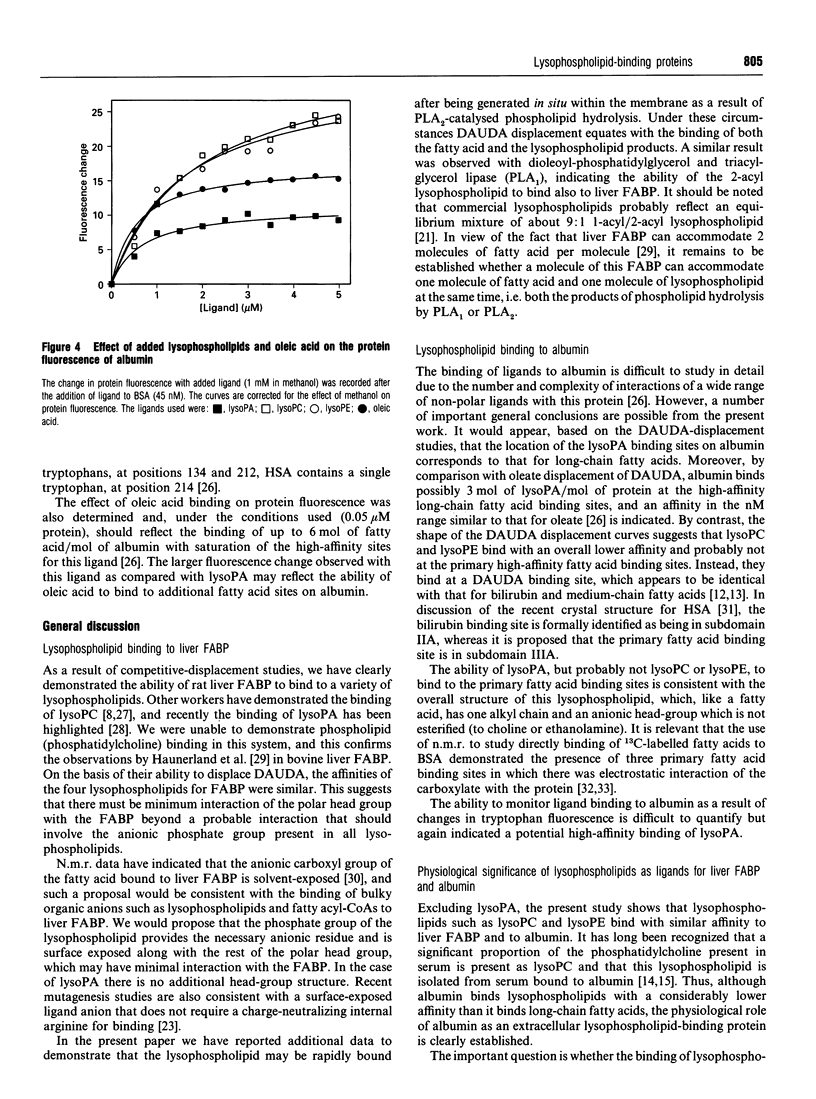
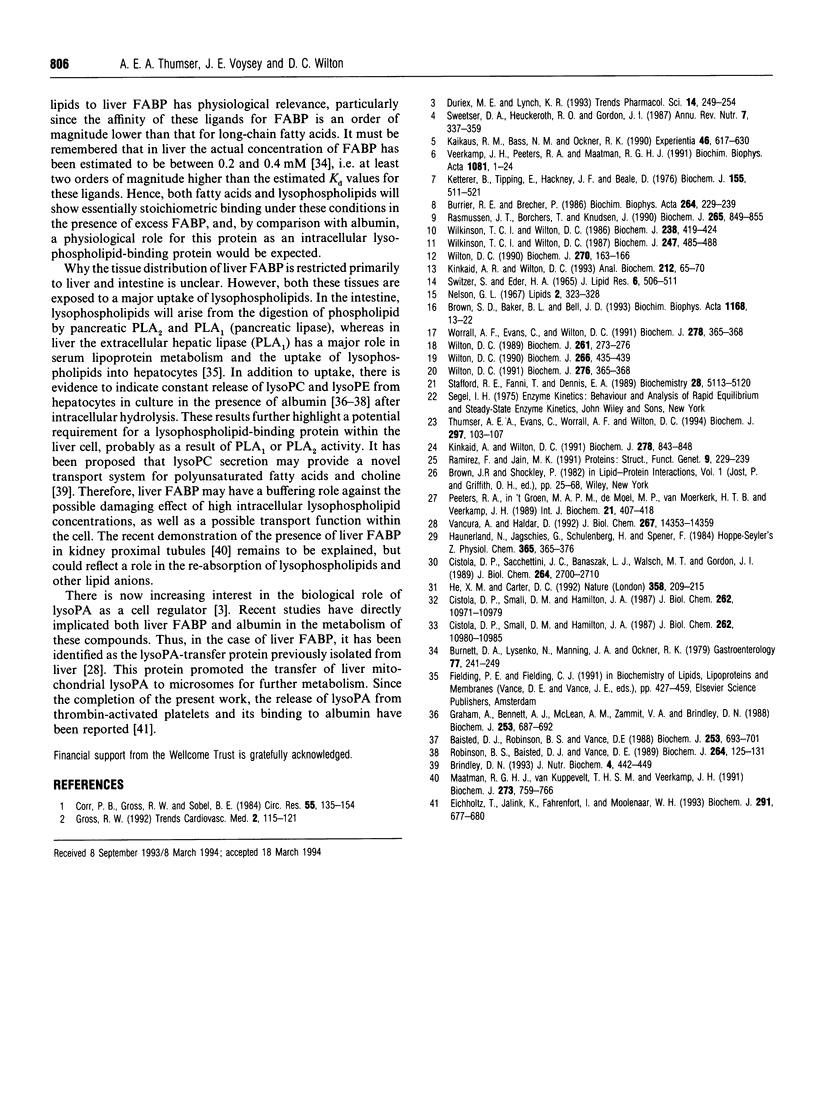
Selected References
These references are in PubMed. This may not be the complete list of references from this article.
- Baisted D. J., Robinson B. S., Vance D. E. Albumin stimulates the release of lysophosphatidylcholine from cultured rat hepatocytes. Biochem J. 1988 Aug 1;253(3):693–701. doi: 10.1042/bj2530693. [DOI] [PMC free article] [PubMed] [Google Scholar]
- Brown S. D., Baker B. L., Bell J. D. Quantification of the interaction of lysolecithin with phosphatidylcholine vesicles using bovine serum albumin: relevance to the activation of phospholipase A2. Biochim Biophys Acta. 1993 May 20;1168(1):13–22. doi: 10.1016/0005-2760(93)90260-g. [DOI] [PubMed] [Google Scholar]
- Burnett D. A., Lysenko N., Manning J. A., Ockner R. K. Utilization of long chain fatty acids by rat liver: studies of the role of fatty acid binding protein. Gastroenterology. 1979 Aug;77(2):241–249. [PubMed] [Google Scholar]
- Burrier R. E., Brecher P. Binding of lysophosphatidylcholine to the rat liver fatty acid binding protein. Biochim Biophys Acta. 1986 Nov 14;879(2):229–239. doi: 10.1016/0005-2760(86)90107-4. [DOI] [PubMed] [Google Scholar]
- Cistola D. P., Sacchettini J. C., Banaszak L. J., Walsh M. T., Gordon J. I. Fatty acid interactions with rat intestinal and liver fatty acid-binding proteins expressed in Escherichia coli. A comparative 13C NMR study. J Biol Chem. 1989 Feb 15;264(5):2700–2710. [PubMed] [Google Scholar]
- Cistola D. P., Small D. M., Hamilton J. A. Carbon 13 NMR studies of saturated fatty acids bound to bovine serum albumin. I. The filling of individual fatty acid binding sites. J Biol Chem. 1987 Aug 15;262(23):10971–10979. [PubMed] [Google Scholar]
- Cistola D. P., Small D. M., Hamilton J. A. Carbon 13 NMR studies of saturated fatty acids bound to bovine serum albumin. II. Electrostatic interactions in individual fatty acid binding sites. J Biol Chem. 1987 Aug 15;262(23):10980–10985. [PubMed] [Google Scholar]
- Corr P. B., Gross R. W., Sobel B. E. Amphipathic metabolites and membrane dysfunction in ischemic myocardium. Circ Res. 1984 Aug;55(2):135–154. doi: 10.1161/01.res.55.2.135. [DOI] [PubMed] [Google Scholar]
- Durieux M. E., Lynch K. R. Signalling properties of lysophosphatidic acid. Trends Pharmacol Sci. 1993 Jun;14(6):249–254. doi: 10.1016/0165-6147(93)90021-b. [DOI] [PubMed] [Google Scholar]
- Eichholtz T., Jalink K., Fahrenfort I., Moolenaar W. H. The bioactive phospholipid lysophosphatidic acid is released from activated platelets. Biochem J. 1993 May 1;291(Pt 3):677–680. doi: 10.1042/bj2910677. [DOI] [PMC free article] [PubMed] [Google Scholar]
- Graham A., Bennett A. J., McLean A. A., Zammit V. A., Brindley D. N. Factors regulating the secretion of lysophosphatidylcholine by rat hepatocytes compared with the synthesis and secretion of phosphatidylcholine and triacylglycerol. Effects of albumin, cycloheximide, verapamil, EGTA and chlorpromazine. Biochem J. 1988 Aug 1;253(3):687–692. doi: 10.1042/bj2530687. [DOI] [PMC free article] [PubMed] [Google Scholar]
- Haunerland N., Jagschies G., Schulenberg H., Spener F. Fatty-acid-binding proteins. Occurrence of two fatty-acid-binding proteins in bovine liver cytosol and their binding of fatty acids, cholesterol, and other lipophilic ligands. Hoppe Seylers Z Physiol Chem. 1984 Mar;365(3):365–376. doi: 10.1515/bchm2.1984.365.1.365. [DOI] [PubMed] [Google Scholar]
- He X. M., Carter D. C. Atomic structure and chemistry of human serum albumin. Nature. 1992 Jul 16;358(6383):209–215. doi: 10.1038/358209a0. [DOI] [PubMed] [Google Scholar]
- Kaikaus R. M., Bass N. M., Ockner R. K. Functions of fatty acid binding proteins. Experientia. 1990 Jun 15;46(6):617–630. doi: 10.1007/BF01939701. [DOI] [PubMed] [Google Scholar]
- Ketterer B., Tipping E., Hackney J. F., Beale D. A low-molecular-weight protein from rat liver that resembles ligandin in its binding properties. Biochem J. 1976 Jun 1;155(3):511–521. doi: 10.1042/bj1550511. [DOI] [PMC free article] [PubMed] [Google Scholar]
- Kinkaid A. R., Wilton D. C. A continuous fluorescence displacement assay for phospholipase A2 using albumin and medium chain phospholipid substrates. Anal Biochem. 1993 Jul;212(1):65–70. doi: 10.1006/abio.1993.1292. [DOI] [PubMed] [Google Scholar]
- Kinkaid A., Wilton D. C. Comparison of the catalytic properties of phospholipase A2 from pancreas and venom using a continuous fluorescence displacement assay. Biochem J. 1991 Sep 15;278(Pt 3):843–848. doi: 10.1042/bj2780843. [DOI] [PMC free article] [PubMed] [Google Scholar]
- Maatman R. G., Van Kuppevelt T. H., Veerkamp J. H. Two types of fatty acid-binding protein in human kidney. Isolation, characterization and localization. Biochem J. 1991 Feb 1;273(Pt 3):759–766. doi: 10.1042/bj2730759. [DOI] [PMC free article] [PubMed] [Google Scholar]
- Nelson G. J. The phospholipid composition of plasma in various mammalian species. Lipids. 1967 Jul;2(4):323–328. doi: 10.1007/BF02532119. [DOI] [PubMed] [Google Scholar]
- Peeters R. A., in 't Groen M. A., de Moel M. P., van Moerkerk H. T., Veerkamp J. H. The binding affinity of fatty acid-binding proteins from human, pig and rat liver for different fluorescent fatty acids and other ligands. Int J Biochem. 1989;21(4):407–418. doi: 10.1016/0020-711x(89)90365-0. [DOI] [PubMed] [Google Scholar]
- Ramirez F., Jain M. K. Phospholipase A2 at the bilayer interface. Proteins. 1991;9(4):229–239. doi: 10.1002/prot.340090402. [DOI] [PubMed] [Google Scholar]
- Rasmussen J. T., Börchers T., Knudsen J. Comparison of the binding affinities of acyl-CoA-binding protein and fatty-acid-binding protein for long-chain acyl-CoA esters. Biochem J. 1990 Feb 1;265(3):849–855. doi: 10.1042/bj2650849. [DOI] [PMC free article] [PubMed] [Google Scholar]
- Robinson B. S., Baisted D. J., Vance D. E. Comparison of albumin-mediated release of lysophosphatidylcholine and lysophosphatidylethanolamine from cultured rat hepatocytes. Biochem J. 1989 Nov 15;264(1):125–131. doi: 10.1042/bj2640125. [DOI] [PMC free article] [PubMed] [Google Scholar]
- Stafford R. E., Fanni T., Dennis E. A. Interfacial properties and critical micelle concentration of lysophospholipids. Biochemistry. 1989 Jun 13;28(12):5113–5120. doi: 10.1021/bi00438a031. [DOI] [PubMed] [Google Scholar]
- Sweetser D. A., Heuckeroth R. O., Gordon J. I. The metabolic significance of mammalian fatty-acid-binding proteins: abundant proteins in search of a function. Annu Rev Nutr. 1987;7:337–359. doi: 10.1146/annurev.nu.07.070187.002005. [DOI] [PubMed] [Google Scholar]
- Switzer S., Eder H. A. Transport of lysolecithin by albumin in human and rat plasma. J Lipid Res. 1965 Oct;6(4):506–511. [PubMed] [Google Scholar]
- Thumser A. E., Evans C., Worrall A. F., Wilton D. C. Effect on ligand binding of arginine mutations in recombinant rat liver fatty acid-binding protein. Biochem J. 1994 Jan 1;297(Pt 1):103–107. doi: 10.1042/bj2970103. [DOI] [PMC free article] [PubMed] [Google Scholar]
- Vancura A., Haldar D. Regulation of mitochondrial and microsomal phospholipid synthesis by liver fatty acid-binding protein. J Biol Chem. 1992 Jul 15;267(20):14353–14359. [PubMed] [Google Scholar]
- Veerkamp J. H., Peeters R. A., Maatman R. G. Structural and functional features of different types of cytoplasmic fatty acid-binding proteins. Biochim Biophys Acta. 1991 Jan 4;1081(1):1–24. doi: 10.1016/0005-2760(91)90244-c. [DOI] [PubMed] [Google Scholar]
- Wilkinson T. C., Wilton D. C. Studies on fatty acid-binding proteins. The binding properties of rat liver fatty acid-binding protein. Biochem J. 1987 Oct 15;247(2):485–488. doi: 10.1042/bj2470485. [DOI] [PMC free article] [PubMed] [Google Scholar]
- Wilkinson T. C., Wilton D. C. Studies on fatty acid-binding proteins. The detection and quantification of the protein from rat liver by using a fluorescent fatty acid analogue. Biochem J. 1986 Sep 1;238(2):419–424. doi: 10.1042/bj2380419. [DOI] [PMC free article] [PubMed] [Google Scholar]
- Wilton D. C. A continuous fluorescence displacement assay for the measurement of phospholipase A2 and other lipases that release long-chain fatty acids. Biochem J. 1990 Mar 1;266(2):435–439. doi: 10.1042/bj2660435. [DOI] [PMC free article] [PubMed] [Google Scholar]
- Wilton D. C. Studies on fatty-acid-binding proteins. The purification of rat liver fatty-acid-binding protein and the role of cysteine-69 in fatty acid binding. Biochem J. 1989 Jul 1;261(1):273–276. doi: 10.1042/bj2610273. [DOI] [PMC free article] [PubMed] [Google Scholar]
- Wilton D. C. The fatty acid analogue 11-(dansylamino)undecanoic acid is a fluorescent probe for the bilirubin-binding sites of albumin and not for the high-affinity fatty acid-binding sites. Biochem J. 1990 Aug 15;270(1):163–166. doi: 10.1042/bj2700163. [DOI] [PMC free article] [PubMed] [Google Scholar]
- Worrall A. F., Evans C., Wilton D. C. Synthesis of a gene for rat liver fatty-acid-binding protein and its expression in Escherichia coli. Biochem J. 1991 Sep 1;278(Pt 2):365–368. doi: 10.1042/bj2780365. [DOI] [PMC free article] [PubMed] [Google Scholar]
- Worrall A. F., Evans C., Wilton D. C. Synthesis of a gene for rat liver fatty-acid-binding protein and its expression in Escherichia coli. Biochem J. 1991 Sep 1;278(Pt 2):365–368. doi: 10.1042/bj2780365. [DOI] [PMC free article] [PubMed] [Google Scholar]


